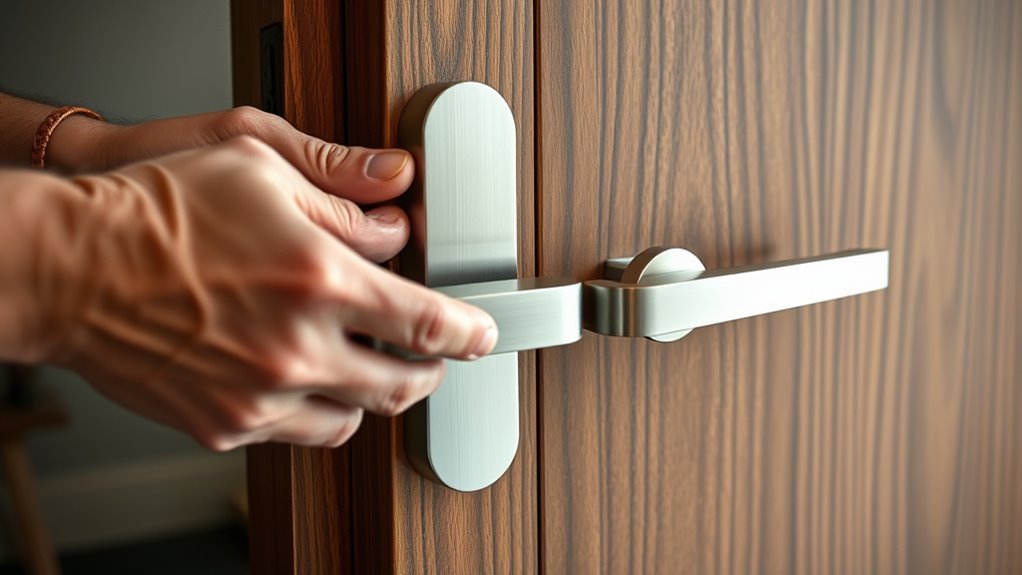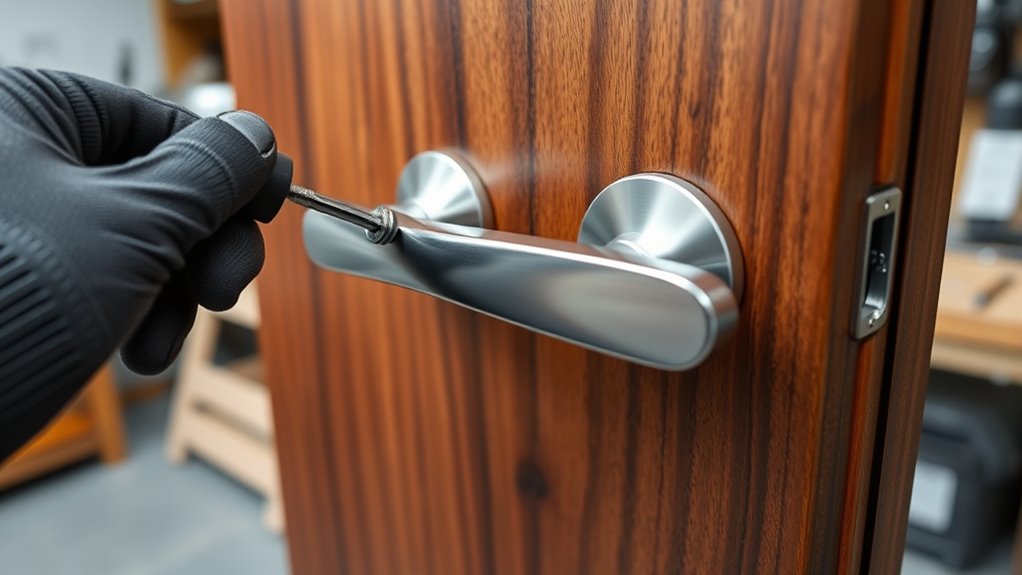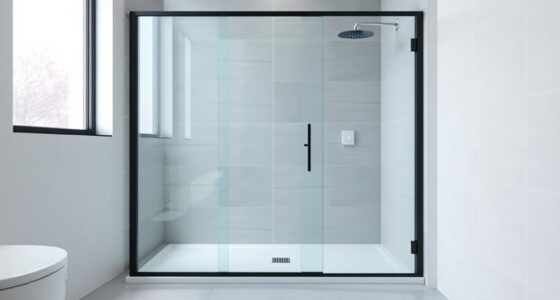To install lever handles instead of knobs, start by removing the existing hardware and examining how it’s attached. Align the new handle components with existing holes or drill new ones if needed. Insert the spindle through the latch, then attach the handles on both sides, securing them with screws. Tighten everything properly and test the handle for smooth operation. If you keep going, you’ll discover more tips to guarantee a perfect and easy installation.
Key Takeaways
- Remove existing door knobs and note how they are attached before starting installation.
- Align the new lever handle components with the door’s pre-drilled holes or create new ones if needed.
- Attach handle plates on both sides of the door, ensuring the spindle passes through the latch mechanism.
- Secure the handles with screws, tightening them properly for smooth operation.
- Test the lever handles for ease of use, adjusting as necessary to ensure proper alignment and function.

Have you ever wondered how to install lever handles on your doors? Replacing traditional knobs with lever handles is a straightforward process that can markedly improve your door’s functionality and aesthetics. When it comes to door hardware, lever handles are a popular choice because they’re easier to operate than knobs, especially for individuals with limited hand strength or dexterity. This is because lever handles require less grip strength and can be pushed down or pulled up with minimal effort. As a result, they offer notable ergonomics benefits, making everyday tasks more manageable and reducing strain on your hands and wrists. Vetted, whether you’re upgrading for accessibility reasons or simply want a more modern look, installing lever handles can be a smart, practical upgrade.
Installing lever handles improves door function and style, offering easier operation and enhanced ergonomics for all users.
To begin, you’ll want to gather the necessary tools and parts, including your new lever handle set, a screwdriver, a drill (if new holes are needed), and possibly a measuring tape. Before removing your existing knob or handle, take a moment to examine your current door hardware and note how it’s attached. Most lever handles come with detailed instructions, but generally, you’ll need to unscrew the existing hardware from both sides of the door. Keep the screws in a safe place—you might need them if you decide to switch back to knobs later. Once the old hardware is removed, clean the area around the holes to guarantee a smooth fit for the new lever handle.
Installing the new lever handle involves aligning the handle components with the pre-drilled holes or creating new ones if necessary. Many lever handles are designed to fit standard door preparations, but check the manufacturer’s specifications beforehand. Insert the spindle through the latch mechanism, then attach the handle plates on both sides, securing them with screws. Make sure the handle moves smoothly and that the latch operates correctly. Proper alignment is vital to guarantee the handle feels comfortable and functions properly. Once everything is tightened and aligned, test the handle several times to confirm it opens and closes the door easily without sticking or feeling loose.
Switching to lever handles not only upgrades your door hardware but also enhances the overall ease of use in your space. The ergonomic benefits are especially noticeable for children, seniors, or anyone with mobility challenges. Plus, lever handles tend to have a sleeker, more contemporary appearance, giving your doors a fresh look. With just a little effort and the right tools, you can enjoy the convenience and ergonomic advantages of your new lever handles in no time. This simple upgrade makes a profound difference in the functionality and comfort of your doors, ensuring they work efficiently for years to come.
Frequently Asked Questions
Are Lever Handles Suitable for All Door Types?
Yes, lever handles are suitable for most door types, but you should check door compatibility first. They work well on interior and exterior doors, including those with standard or custom styles. Different lever handle styles can match your decor. Confirm your door’s thickness and latch mechanism are compatible with the lever handle to avoid installation issues. Overall, lever handles provide an accessible, stylish option for many doors.
How Do I Adjust Lever Handles for Easier Grip?
To adjust lever handles for an ergonomic grip, start by checking if they have lever height adjustment features; if so, use the screws or mechanisms provided to set the handle at a comfortable height for easy access. If not, consider replacing the handle with one that offers adjustable lever height. Ensuring the lever is positioned correctly reduces strain, making it easier to operate and improving overall grip comfort.
Can Lever Handles Be Installed on Existing Locksets?
Did you know that about 80% of locksets are compatible with lever handle installation? Yes, you can typically install lever handles on existing locksets, but it depends on lockset compatibility. To do this, you need to verify the lock’s design and size. Most modern locksets support lever handle installation, making it a straightforward upgrade. Just make certain your lockset is compatible before starting, and you’ll enjoy easier grip and accessibility.
What Are the Safety Features of Lever Handles?
Lever handles often come with safety features like easy-to-operate designs, reducing the risk of injury, especially for children or those with limited strength. They also offer ergonomic benefits, making them comfortable and straightforward to use. Plus, lever handles provide a variety of aesthetic options, allowing you to match your decor while ensuring safety. Their smooth, accessible operation enhances security and convenience in your space.
Are Lever Handles More Durable Than Knobs?
Think of lever handles as the sturdy oak in your door garden—more durable than fragile twigs. You’ll appreciate their ergonomic benefits, making them easier to operate, especially for those with limited strength. Plus, they offer a variety of aesthetic options to match your style. Because of their robust construction, lever handles tend to last longer and withstand daily wear better than knobs, making them a smart, lasting choice.
Conclusion
As you finish installing your new lever handles, you’ll notice how seamlessly they fit into your daily routine. Coincidentally, the smooth operation reminds you of that quiet afternoon you spent updating your home’s details, turning a simple upgrade into a small act of comfort. Now, every time you open the door, it’s a gentle reminder that a little effort can make a big difference. Your space feels more welcoming, all thanks to your thoughtful touch.








